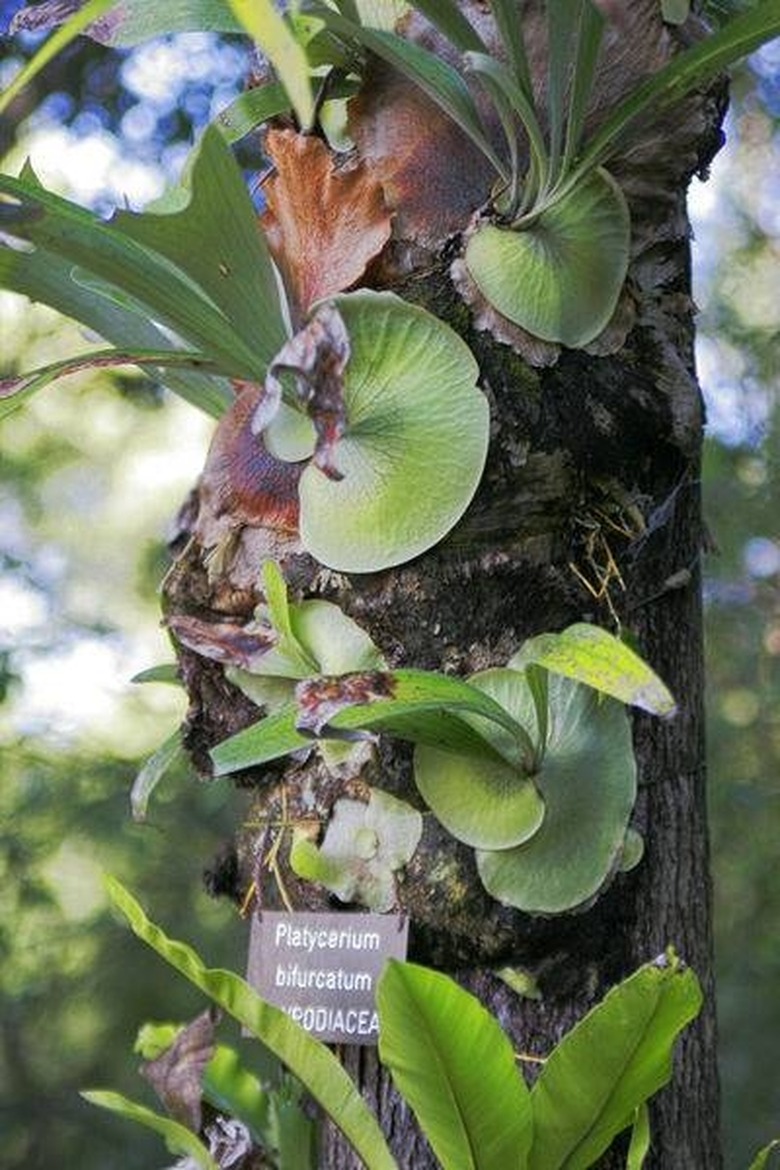About Staghorn Ferns
Staghorn ferns earn their name from the resemblance to deer horns or antlers. Mounted on a slab of wood and displayed from the wall, these impressive plants provide the illusion of real stag horns. Often displayed in rustic or country settings the staghorn fern provides a bit of green in shaded areas and requires little care other than watering and misting on a regular basis.
Origins
Origins
The staghorn fern, Platycerium bifurcatum, originated in tropical Australia and New Guinea where it grows on trees in filtered light and thrives in areas with high humidity. It reaches a size of 3 to 4 feet, depending on the growing conditions.
Reproduction
Reproduction
Staghorn ferns do not bloom and reproduce by spores located on the underside of leaves. In the natural environment, spores are released into the air and new plants generally take root in a nearby tree or along the base of the same tree. The plant grows from a rhizome and may spread by multiple rhizomes, which send out new shoots and develop into a new plant.
Water Retension
Water Retension
Staghorn ferns produce both cup shaped and antler shaped fronds. The cup shaded fronds near the base of the plant help secure the fern to trees and work to collect water. The design of the frond catches and holds rainwater shed from the leaves of the host tree. In temperate regions, staghorn ferns can be grown outside. With adequate rainfall, the plant will thrive as long as it is not exposed to prolonged direct sunlight. In dry areas, it must be watered often to prevent the roots from drying out.
Houseplants
Houseplants
As a houseplant, staghorn ferns can be grown in either a potting medium of all-purpose potting soil or grown in sphagnum moss adhered to a slab of wood. To create a planting on wood for display, secure small nails into the base of the wooden slab that is slightly wider than the base of the fern. Place moist sphagnum moss between the nails and place the fern atop the moss. Secure in place with fishing line or craft wire. Keep the moss moist and mist the fern daily. The fern will quickly grow to cover the wires and appear to be sprouting form the slab of wood. Place in a warm location that receives filtered light and mist daily to maintain the humidity level. Water by soaking the slab of wood and the fern in tepid water whenever the moss dries.
New Plants
New Plants
Propagate staghorn ferns by cutting newly formed rhizomes and the resulting ferns from the base of the mother fern leaving a small section of moss attached to the roots. Place the new ferns on a slab of moss-covered wood and wire in place. Two or three young ferns can be used in one planting.
Cite This Article
MLA
Richford, Nannette. "About Staghorn Ferns" sciencing.com, https://www.sciencing.com/staghorn-ferns-4728141/. 22 November 2019.
APA
Richford, Nannette. (2019, November 22). About Staghorn Ferns. sciencing.com. Retrieved from https://www.sciencing.com/staghorn-ferns-4728141/
Chicago
Richford, Nannette. About Staghorn Ferns last modified March 24, 2022. https://www.sciencing.com/staghorn-ferns-4728141/
